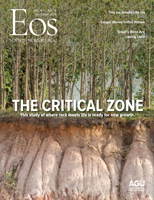During a phone call to discuss article ideas back in January, Andrew Wilcox told me: We really should do some coverage of the critical zone. Wilcox is Eos’s science adviser representing AGU’s Earth and Planetary Surface Processes section, as well as a professor of geomorphology at the University of Montana and, yes, a critical zone scientist.
The motivation wasn’t any single research project—though, of course, there is a ton of fascinating work in this field, as you’ll see inside this issue—it was more a matter of recognition. The term critical zone is still new. Most geoscience programs don’t offer a critical zone focus or even a class on the topic. The critical zone is, in simplest terms, the area of our planet stretching from the treetops down to the bottom of the groundwater. Critical zone scientists study everything and every interaction within it. “Framing Earth processes in the context of critical zone science is a way to underscore multiple dimensions of connectivity in terms of how water, sediment, nutrients, and biota move across landscapes; between scientific disciplines; and between humans and the environment,” said Wilcox.
Our first step in planning the issue was a call with Adam Ward, one of our science advisers representing AGU’s Hydrology section and an associate professor at Indiana University, who pointed us to the Critical Zone Research Coordination Network. This National Science Foundation (NSF)–funded project aims to bridge the gap between scientists working in the varied fields across the critical zone by creating inclusive language, reaching out to minoritized geoscientist networks, and coaching senior scientists on how to reach out. “If we are to do our research successfully, diverse alliances are important,” write Kamini Singha and her coauthors in this issue.
If you’ve heard the term critical zone, it’s likely due to NSF’s Critical Zone Observatories. The nine remaining observatories, launched over the past 13 years, will reach the end of their successful run next year, when program funding expires. Research initiated at those facilities now stretches far past them—there are critical zone sites around the world, and NSF recently announced funding for nine new critical zone collaborative networks to take the baton, as well as a hub to coordinate critical zone research. Read more in our Critical Zone special issue.
The stars seem perhaps within our reach, but not on any time frame a single career would allow.
Speaking of handing off projects to the next generation, read about the teams that are figuring out how to plan a space mission knowing it will have to be passed down to, quite literally, the next generation. With the Voyager spacecraft traveling beyond our solar system, the stars seem perhaps within our reach, but not on any time frame a single career would allow. People behind the proposed Interstellar Probe are creating a model for the kind of long-lasting spacefaring missions that may not even launch until their own grandkids are retiring.
One last piece of exciting news! As we look forward to hosting you virtually during #AGU20 Fall Meeting this December, Eos wanted to contribute something unique to the event. Watch for our combined November–December special double issue, packed with news and features looking at how the geoscience community adapted to the major challenges of 2020. Check your mailboxes in mid-November for this exciting issue of Eos.
—Heather Goss (@heathermg), Editor in Chief
Citation:
Goss, H. (2020), Next steps for the critical zone, Eos, 101, https://doi.org/10.1029/2020EO149358. Published on 24 September 2020.
Text © 2020. AGU. CC BY-NC-ND 3.0
Except where otherwise noted, images are subject to copyright. Any reuse without express permission from the copyright owner is prohibited.
Text © 2020. AGU. CC BY-NC-ND 3.0
Except where otherwise noted, images are subject to copyright. Any reuse without express permission from the copyright owner is prohibited.


